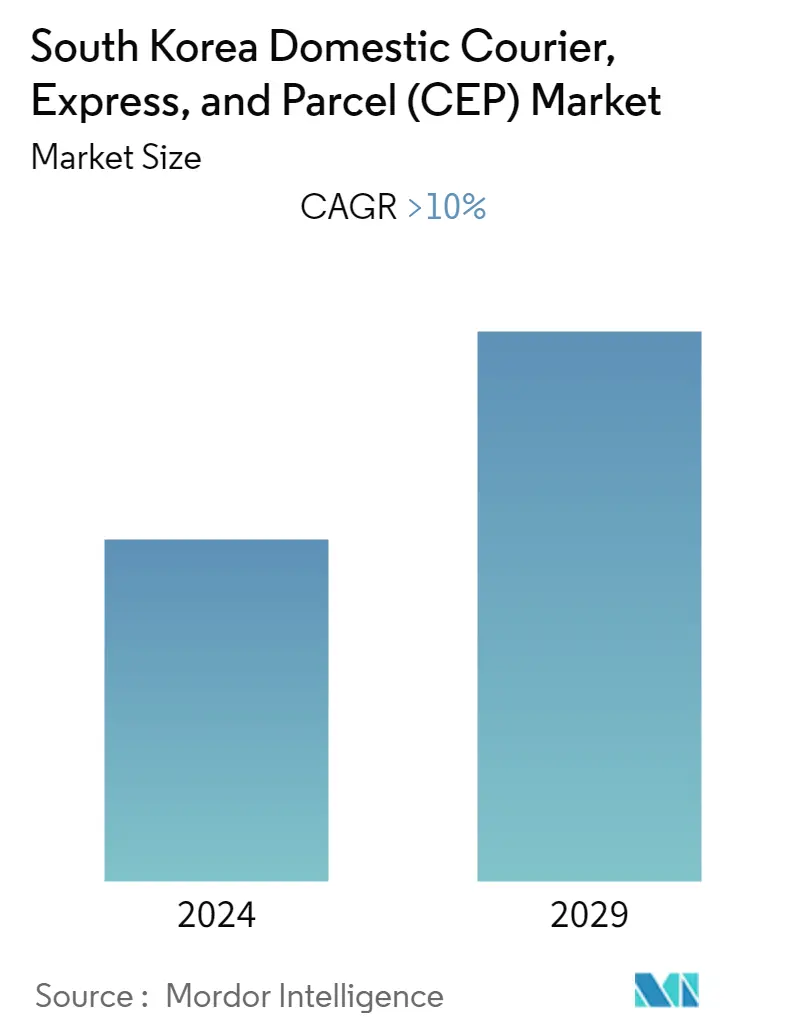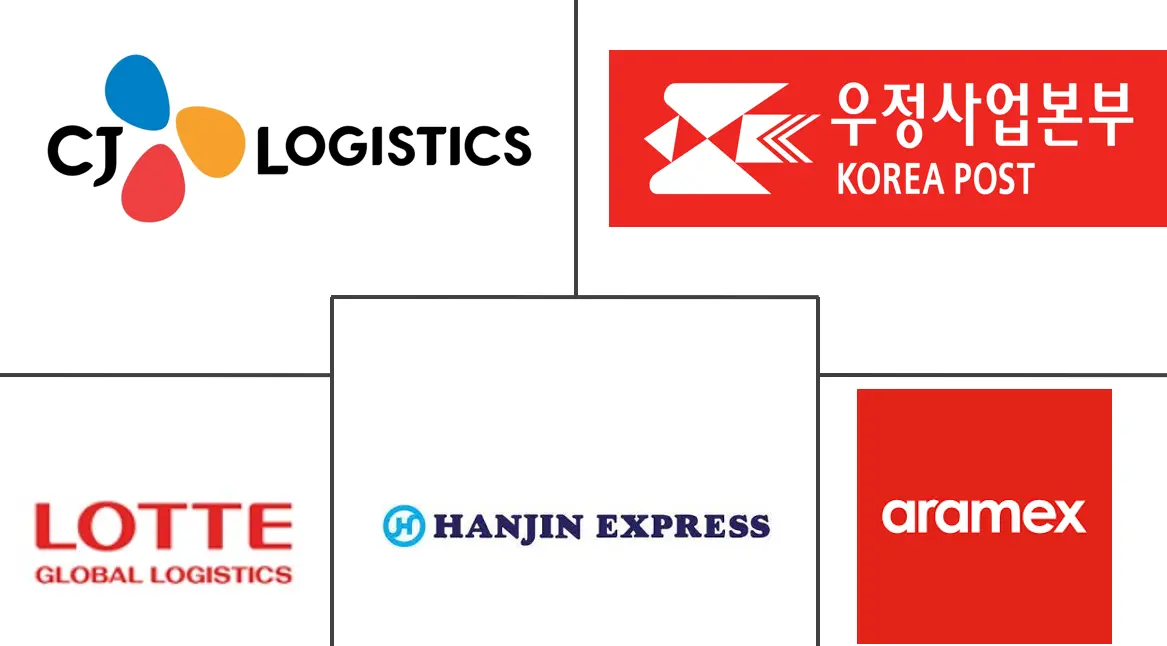
| Study Period | 2020 - 2029 |
| Base Year For Estimation | 2023 |
| Forecast Data Period | 2024 - 2029 |
| Historical Data Period | 2020 - 2022 |
| CAGR | 10.00 % |
| Market Concentration | Low |
Major Players
*Disclaimer: Major Players sorted in no particular order |
South Korean Domestic Courier, Express, and Parcel Market Analysis
The South Korean domestic courier, express, and parcel (CEP) market is expected to register a CAGR of over 10% during the forecast period (2023-2028).
- As a result of the COVID-19 pandemic, distribution infrastructure was expanded across the country outside Seoul and metropolitan centers. The retail industry has stepped up to strengthen the same-day delivery system. As non-face-to-face consumption became commonplace due to the COVID-19 pandemic, an immediate delivery system was introduced, and omnichannel started becoming consolidated.
- Even though the Korean e-commerce market was ranked fourth in the world in 2020, its share of the total retail market, including online and offline sales, was 35.8%, placing it first. The number of online market transactions exceeded USD 155 billion in 2021.
- Moreover, In September 2022, online shoppers in South Korea spent more than USD 1.93 billion on food and beverages, USD 1.18 billion on clothing, USD 750 million on cosmetics, and USD 1.1 billion on household goods.
- The leader among online shopping properties active as of September 2021 is Coupang. Their fast next-day delivery service is one of their most prized services. Coupang defeated G-market, an eBay-owned website, after months of increasing market share.
- However, in 2021, the South Korean Trade, Industry, and Energy Ministry planned to invest more than USD 267 million to accelerate the growth of online retail in the country, and this investment was made over the next three years. in addition, Ministry planned to develop unmanned delivery services across the country, as well as more than 4,000 logistics robots will be distributed by 2023. Thus, the growing e-commerce sector and government initiatives will drive the domestic express and parcel delivery industry in the country.
South Korean Domestic Courier, Express, and Parcel Industry Segmentation
Domestic Courier, express, and parcel (CEP) refers to the collection of services that involves the delivery of various goods and products through different mediums such as air, water, and land within the country. These packages delivered by CEP are mainly non-palletized and weigh around a hundred pounds collectively. Furthermore, the report offers a complete background analysis of the South Korea domestic courier, express, and parcel (CEP) market, including a market overview, market size estimation for critical segments, emerging trends by segment, and market dynamics.
The South Korean domestic courier, express, and parcel market is segmented by business model (business-to-business (B2B), business-to-customer (B2C), and customer-to-customer (C2C)), by type (e-commerce and non e-commerce), and by end user (service, wholesale and retail trade, healthcare, industrial manufacturing, and other end users). The report offers size and forecasts for the South Korean domestic courier, express, and parcel market in value (USD billion) for all the above segments. The impact of the COVID-19 pandemic is also covered in the report.
| Business-to-Business (B2B) |
| Business-to-Customer (B2C) |
| Customer-to-Customer (C2C) |
| E-commerce |
| Non E-commerce |
| Services |
| Wholesale and Retail Trade |
| Healthcare |
| Industrial Manufacturing |
| Other End Users |
South Korea Domestic Courier, Express, and Parcel (CEP) Market Size Summary
The South Korean domestic courier, express, and parcel (CEP) market is poised for significant growth, driven by the expansion of distribution infrastructure and the rise of e-commerce. The COVID-19 pandemic accelerated the adoption of same-day delivery systems and omnichannel retailing, enhancing the efficiency of logistics networks beyond metropolitan areas. South Korea's e-commerce sector, a global leader, has seen substantial online transaction volumes, with major players like Coupang leading the charge with rapid delivery services. Government initiatives, including substantial investments in online retail and the development of unmanned delivery services, are further propelling the growth of the CEP industry. The market is characterized by intense competition among both global and local players, with companies like CJ Logistics, Korea Post, and Hanjin Express vying for market share.
Retail sales in South Korea have experienced robust growth, with both online and offline channels contributing to the surge. The easing of pandemic restrictions has boosted demand for various goods and services, with online platforms seeing significant increases in sales. The trend of mobile shopping continues to rise, with South Koreans increasingly embracing the convenience of online purchases across diverse product categories. The market's competitive landscape is marked by ongoing investments and innovations, such as live commerce and advanced logistics facilities. As the market evolves, it is expected to undergo consolidation through mergers and acquisitions, potentially leading to a more monopolistic structure. The continued expansion of internet access, urbanization, and technological advancements are anticipated to sustain the market's growth trajectory in the coming years.
South Korea Domestic Courier, Express, and Parcel (CEP) Market Size - Table of Contents
1. MARKET DYNAMICS
- 1.1 Market Drivers
- 1.2 Market Restraints/Challenges
- 1.3 Market Opportunities
-
1.4 Industry Attractiveness - Porter's Five Forces Analysis
- 1.4.1 Threat of New Entrants
- 1.4.2 Bargaining Power of Buyers/Consumers
- 1.4.3 Bargaining Power of Suppliers
- 1.4.4 Threat of Substitute Products
- 1.4.5 Intensity of Competitive Rivalry
2. MARKET SEGMENTATION
-
2.1 By Business Model
- 2.1.1 Business-to-Business (B2B)
- 2.1.2 Business-to-Customer (B2C)
- 2.1.3 Customer-to-Customer (C2C)
-
2.2 By Type
- 2.2.1 E-commerce
- 2.2.2 Non E-commerce
-
2.3 By End User
- 2.3.1 Services
- 2.3.2 Wholesale and Retail Trade
- 2.3.3 Healthcare
- 2.3.4 Industrial Manufacturing
- 2.3.5 Other End Users
South Korean Domestic Courier, Express, and Parcel Market Research FAQs
What is the current South Korea Domestic Courier, Express, and Parcel (CEP) Market size?
The South Korea Domestic Courier, Express, and Parcel (CEP) Market is projected to register a CAGR of greater than 10% during the forecast period (2024-2029)
Who are the key players in South Korea Domestic Courier, Express, and Parcel (CEP) Market?
CJ Logistics, Korea Post , Lotte Global Logistics, Hanjin Express and Aramex are the major companies operating in the South Korea Domestic Courier, Express, and Parcel (CEP) Market.


